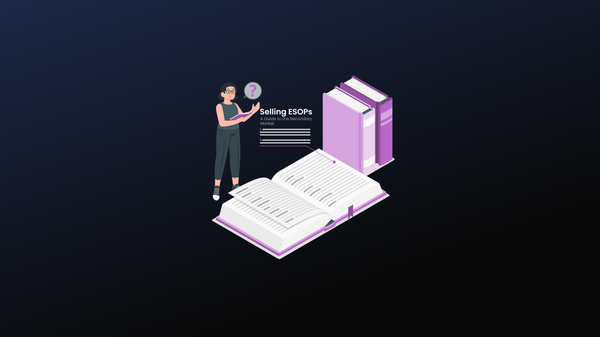Complete Guide to Employee Stock Option Plans (ESOPs) in India: Implementation, Legal Framework & Best Practices 2025
Table of Contents
- What is an ESOP? Complete Definition & Overview
- Legal Framework & Regulatory Requirements
- Step-by-Step ESOP Implementation Process
- ESOP Pool Setup & Equity Distribution
- Key ESOP Terms & Concepts
- Taxation of ESOPs in India (2025 Update)
- Documentation & Compliance Requirements
- Best Practices for Startups vs Established Companies
- Common Mistakes to Avoid
- FAQs & Expert Tips
What is an ESOP? Complete Definition & Overview.
Employee Stock Option Plans (ESOPs) are employee benefit schemes that grant workers the right to purchase company shares at a predetermined price within a specified timeframe. Unlike immediate stock grants, ESOPs provide options that employees can exercise later, creating a powerful tool for talent retention and wealth creation.
Key Benefits of Offering ESOP
For Employees:
- Ownership stake in company growth and success
- Potential wealth creation through share price appreciation
- Tax advantages with proper planning
- Long-term financial incentive beyond salary
- Motivation to contribute to company performance
For Companies:
- Talent attraction and retention tool
- Cash flow preservation (equity instead of cash compensation)
- Employee motivation aligned with company goals
- Tax deductions on ESOP contributions
- Competitive advantage in hiring
Legal Framework & Regulatory Requirements
Applicable Laws and Regulations
For Private Companies:
- Companies Act, 2013 - Sections 2(37), 62(1)(b)
- Companies (Share Capital and Debentures) Rules, 2014 - Rule 12
- Income Tax Act, 1961 - Section 17(2) for taxation
For Listed Companies:
- SEBI (Share Based Employee Benefits and Sweat Equity) Regulations, 2021
- Additional disclosure and valuation requirements
Updated Legal Requirements (2025)
Recent Changes:
- Capital gains tax rates updated: LTCG at 12.5% (above ₹1.25 lakh), STCG at 20%
- Holding period simplified: 12 months for listed securities, 24 months for unlisted
- Enhanced compliance requirements for private companies
- Stricter valuation norms for share pricing
Eligibility Criteria
Who Can Receive ESOPs:
- Permanent employees (India or overseas)
- Whole-time and part-time directors (excluding independent directors)
- Employees of subsidiary, holding, or associate companies
Exclusions:
- Promoters or promoter group members
- Directors holding >10% equity (directly or indirectly)
- Exception: Startup companies get 10-year relaxation from incorporation date
Step-by-Step Process for Implementing Employee Stock Option Plan:
Phase 1: Planning & Preparation
1. Feasibility Study
- Assess financial impact on company valuation
- Determine optimal ESOP pool size (typically 10-20% of equity)
- Analyze cash flow implications
- Benchmark against industry standards
2. Legal Structure Review
- Check Articles of Association (AoA) for ESOP authorization
- Review Memorandum of Association (MoA) for adequate authorized capital
- Ensure compliance with applicable regulations
3. Professional Consultation
- Engage qualified Company Secretary
- Consult tax advisor for optimization
- Obtain legal counsel for documentation
Phase 2: Board Resolution & Documentation
4. Board Meeting Preparation
- Draft comprehensive ESOP scheme
- Prepare board resolution template
- Send 7-day advance notice to all directors
5. Board Resolution Passage
- Approve ESOP scheme implementation
- Determine exercise price methodology
- Set vesting schedule and conditions
- Authorize calling of General Meeting
- Appoint ESOP committee (if required)
6. Post-Board Compliance
- File Form MGT-14 within 15 days
- Circulate meeting minutes to directors
- Prepare shareholder meeting documentation
Phase 3: Shareholder Approval
7. General Meeting Notice
- Send 21-day advance notice to all stakeholders
- Include detailed explanatory statement
- Provide ESOP scheme disclosure requirements
8. Special Resolution
- Pass special resolution with 75% majority
- Address shareholder queries and concerns
- Document voting results properly
9. Post-Meeting Compliance
- File Form MGT-14 within 30 days
- Update statutory registers
- Inform stock exchanges (for listed companies)
Phase 4: Implementation & Grant
10. Share Valuation
- Obtain Registered Valuer report for Fair Market Value
- Update valuation annually or as required
- Maintain supporting documentation
11. Employee Grants
- Issue individual grant letters to eligible employees
- Maintain Register of Employee Stock Options (Form SH-6)
- Implement tracking and monitoring systems
12. Ongoing Administration
- Process option exercises and share allotments
- Handle forfeitures and lapses
- Maintain compliance with vesting schedules
How big should the ESOP Pool be?
Industry Benchmarks:
- Early-stage startups: 15-25% of total equity
- Growth-stage companies: 10-15% of total equity
- Mature companies: 5-10% of total equity
Factors to Consider:
- Company stage and growth trajectory
- Industry competition for talent
- Cash compensation constraints
- Future hiring requirements
- Dilution impact on existing shareholders
How much ESOP should you give your employees?
Recommended Allocation by Role Level:
| Role Level | Equity Range | Typical Vesting |
|---|---|---|
| C-Level Executives | 0.5% - 3.0% | 4 years |
| Vice Presidents | 0.25% - 1.0% | 4 years |
| Directors/Senior Managers | 0.1% - 0.5% | 3-4 years |
| Managers | 0.05% - 0.25% | 3-4 years |
| Senior Individual Contributors | 0.01% - 0.1% | 3-4 years |
| Junior Employees | 0.001% - 0.05% | 2-3 years |
Early Employee Premiums:
- First 10 employees: 25-50% higher allocation
- First 50 employees: 10-25% higher allocation
- Key technical hires: Additional 10-30% premium
Key ESOP Terms & Concepts
Critical ESOP Terminology
Grant Date The date when options are awarded to employees. No taxation occurs at this stage.
Exercise Price (Strike Price) The predetermined price at which employees can purchase shares. Must be ≥ face value of shares.
Fair Market Value (FMV) Current market value of shares, determined by:
- Listed companies: Stock exchange price
- Private companies: Registered Valuer assessment
Vesting Period Time duration before employees can exercise options. Minimum 1 year required between grant and vesting.
Exercise Period Window during which vested options can be converted to shares. Typically 5-10 years from grant date.
Lock-in Period Duration after exercise during which shares cannot be sold. Usually 6-18 months for private companies.
ESOP Lifecycle Stages
1. Grant → 2. Vest → 3. Exercise → 4. Sale
Each stage has distinct legal, tax, and administrative implications requiring careful management.
Taxation of ESOPs in India (2025 Update)
Tax Treatment Overview
ESOP taxation occurs at two distinct stages with different tax implications:
Stage 1: Exercise of Options (Perquisite Tax)
Taxable Event: When employee exercises options and receives shares Tax Base: FMV on exercise date minus exercise price Tax Rate: As per individual income tax slab rates Tax Deduction: TDS by employer mandatory
Example Calculation:
Exercise Date FMV: ₹100 per share
Exercise Price: ₹20 per share
Taxable Perquisite: ₹80 per share
Tax @ 30% (assuming top slab): ₹24 per share
Stage 2: Sale of Shares (Capital Gains Tax)
Tax Base: Sale price minus FMV on exercise date Classification: Based on holding period from exercise date
2025 Tax Rates:
Listed Shares:
- Short-term (≤12 months): 20% tax rate
- Long-term (>12 months): 12.5% tax rate (exemption up to ₹1.25 lakh)
Unlisted Shares:
- Short-term (≤24 months): As per income tax slab rates
- Long-term (>24 months): 12.5% tax rate (no indexation benefit)
Tax Planning Strategies
For Employees:
- Plan exercise timing to optimize tax brackets
- Consider staggered exercise approach
- Maintain proper holding periods for LTCG benefits
- Keep detailed records of all transactions
For Employers:
- Implement proper TDS systems
- Provide tax education to employees
- Consider tax equalization for senior hires
- Maintain compliance documentation
Special Provisions for Startups
Section 80-IAC Benefits:
- Eligible startups can defer tax liability
- Tax payable within 14 days of earliest:
- 5 years from ESOP allotment
- Date of share sale
- Employment termination
Documentation & Compliance Requirements
Essential Legal Documents
1. ESOP Scheme Document
- Comprehensive scheme rules and regulations
- Eligibility criteria and allocation methodology
- Vesting and exercise procedures
- Administration and governance framework
2. Board Resolutions
- ESOP scheme approval resolution
- Individual grant approval resolutions
- Exercise price determination resolutions
- Committee appointment resolutions
3. Shareholder Resolutions
- Special resolution for ESOP implementation
- Increase in authorized capital (if required)
- Amendment to Articles of Association
4. Employee Documentation
- Grant Letters: Individual option grant agreements
- Exercise Letters: Share allotment requests
- Consent Forms: Employee acknowledgment documents
5. Regulatory Filings
- Form MGT-14: Board and shareholder resolutions
- Form SH-6: Register of Employee Stock Options
- Annual Return updates: Reflect ESOP details
- Income Tax filings: TDS and perquisite reporting
Ongoing Compliance Requirements
Monthly Tasks:
- Update employee stock option registers
- Process option exercises and share allotments
- Calculate and deposit TDS on exercises
Quarterly Tasks:
- Review vesting schedules and eligibility
- Update Fair Market Value assessments
- File TDS returns and compliance reports
Annual Tasks:
- Comprehensive ESOP scheme review
- Board approval for new grants
- Statutory audit of ESOP transactions
- Annual return and regulatory filings
Best Practices for Startups vs Established Companies
For Early-Stage Startups
ESOP Design Principles:
- Generous pool allocation (15-25%) to attract talent
- Accelerated vesting for key early employees
- Performance-based vesting milestones
- Flexible exercise terms to accommodate cash flow
Implementation Focus:
- Simple, cost-effective documentation
- Clear communication about potential value
- Regular valuation updates and transparency
- Employee education on ESOP mechanics
Common Approaches:
- Cliff vesting: 1-year cliff, then monthly/quarterly
- Double trigger vesting: Time + performance milestones
- Early exercise provisions for tax optimization
- Buyback rights for departing employees
For Established Companies
ESOP Design Principles:
- Moderate pool allocation (5-15%) for retention
- Standard vesting schedules (3-4 years)
- Market-competitive exercise pricing
- Formal governance and administration
Implementation Focus:
- Comprehensive legal documentation
- Professional valuation processes
- Robust administrative systems
- Integration with broader compensation strategy
Advanced Features:
- Performance Stock Units (PSUs) for executives
- Restricted Stock Units (RSUs) for broader population
- Stock Appreciation Rights (SARs) for cash-settled benefits
- Employee Stock Purchase Plans (ESPPs) for all employees
Common Mistakes to Avoid
Legal and Compliance Mistakes
1. Inadequate Documentation
- Missing or incomplete ESOP scheme documents
- Improper board and shareholder resolutions
- Insufficient employee grant documentation
2. Regulatory Non-Compliance
- Failure to file mandatory forms timely
- Incorrect TDS calculation and deposit
- Missing statutory register maintenance
3. Valuation Errors
- Inaccurate Fair Market Value assessments
- Outdated valuation reports
- Non-compliance with valuation regulations
Design and Implementation Mistakes
4. Poor Pool Planning
- Insufficient ESOP pool for future needs
- Inequitable allocation across employee levels
- Lack of reserve for future hiring
5. Complex Terms
- Overly complicated vesting schedules
- Unclear exercise procedures
- Ambiguous forfeiture conditions
6. Communication Failures
- Inadequate employee education on ESOP benefits
- Missing tax implication explanations
- Poor ongoing communication about value
Administrative Mistakes
7. System Deficiencies
- Manual tracking without proper systems
- Inadequate record keeping
- Missing audit trails
8. Tax Planning Oversights
- Poor timing of option exercises
- Missing tax optimization opportunities
- Inadequate employer TDS processes
Frequently Asked Questions
Q1: What's the minimum ESOP pool size for a startup? A: There's no legal minimum, but 10-15% is typical for early-stage startups to remain competitive in talent acquisition while managing dilution.
Q2: Can ESOPs be offered to future employees? A: Yes, ESOP schemes can explicitly include provisions for future employees, allowing grants as new hires join the company.
Q3: What happens to ESOPs when an employee leaves? A: Unvested options typically lapse, while vested options may have a limited exercise window (usually 90 days). Some companies offer buyback provisions.
Q4: Can exercise price be below face value? A: No, Indian law requires exercise price to be at least equal to the face value of shares, though it can be below market value.
Q5: How often should share valuation be updated? A: Private companies should update valuations annually or upon significant events. Listed companies use market prices.
Q6: Are ESOPs mandatory for all employees? A: No, ESOPs are discretionary benefits. Companies choose eligible employees based on their criteria and business objectives.
Expert Tips for Success
For Companies:
- Start early - Implement ESOPs before significant valuation increases
- Communicate regularly - Keep employees informed about scheme value and performance
- Plan for liquidity - Consider eventual buyback or exit strategies
- Seek professional help - Engage qualified legal and tax advisors
- Benchmark regularly - Review terms against industry standards
For Employees:
- Understand fully - Learn all terms, conditions, and tax implications
- Plan exercise timing - Consider tax optimization and market conditions
- Diversify holdings - Don't concentrate all wealth in company stock
- Keep records - Maintain detailed documentation for tax purposes
- Seek advice - Consult tax professionals for complex situations
Technology Solutions:
- Cap table management platforms
- ESOP administration software
- Valuation and compliance tools
- Employee communication portals
Conclusion
Employee Stock Option Plans represent a powerful tool for aligning employee interests with company success while managing cash flow constraints. Success depends on careful planning, proper legal implementation, ongoing compliance, and clear communication with all stakeholders.
The regulatory landscape continues evolving, making professional guidance essential for optimal ESOP design and implementation. Companies investing in comprehensive ESOP programs often see improved employee retention, motivation, and long-term performance.
This guide provides general information and should not substitute for professional legal, tax, or financial advice. Consult qualified professionals for your specific situation.



